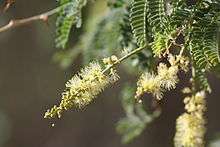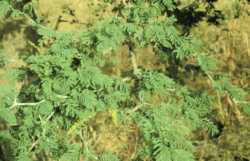Faidherbia
| Faidherbia | |
|---|---|
| | |
| F. albida growing with palms and maize crops | |
| Scientific classification | |
| Kingdom: | Plantae |
| (unranked): | Angiosperms |
| (unranked): | Eudicots |
| (unranked): | Rosids |
| Order: | Fabales |
| Family: | Fabaceae |
| Genus: | Faidherbia A.Chev. |
| Species: | F. albida |
| Binomial name | |
| Faidherbia albida (Delile) A.Chev. | |
 | |
| The range of Faidherbia albida. | |

Faidherbia is a genus of leguminous plants containing one species, Faidherbia albida, native to Africa and the Middle East. The species was formerly widely included in the genus Acacia as Acacia albida. It has also been introduced to Pakistan and India. Common names for it include apple-ring acacia (their circular, indehiscent seed pods resemble apple rings),[1] ana tree, balanzan tree and winter thorn.[2]
It is a thorny tree growing up 6–30 m (20–98 ft) tall and 2 m (6.6 ft) in trunk diameter. Its deep-penetrating tap root makes it highly resistant to drought. The bark is grey, and fissured when old. There are 11,000 seeds/kg. Faidherbia albida is not listed as being a threatened species.[2][3][4]
It grows in areas with 250–600 mm (9.8–23.6 in) of rain per year.[4]
Faiderbia albida is known in the Bambara language as balanzan and is the official tree of the city of Segou on the Niger River in central Mali. According to legend, Segou is home to 4,444 balanzan trees, plus one mysterious "missing tree" the location of which cannot be identified.
In Serer and some of the Cangin languages, it is called Saas. Saas figures prominently in the creation myth of the Serer people. According to their creation myth, it is the tree of life and fertility.[5]
The northernmost natural populations are found in relict groves in Israel (in the Shimron nature reserve, near the communal settlement of Timrat). All of the trees in a given grove are genetically identical and seem to have multiplied by vegetative reproduction only, for thousands of years.
Cultivation and uses
Faidherbia albida is important in the Sahel for raising bees, since its flowers provide bee forage at the close of the rainy season, when most other local plants do not.[6]
The seed pods are important for raising livestock, are used as camel fodder in Nigeria,[6] and are relished by elephant, antelope, buffalo, baboons and various browsers and grazers, though strangely ignored by warthog and zebra.[7]
The wood is used for canoes, mortars, and pestles and the bark is pounded in Nigeria and used as a packing material on pack animals. The wood has a density of about 560 kg/m3 at a water content of 12%.[8] The energy value of the wood as fuel is 19.741 kJ/kg.[6]
Ashes of the wood are used in making soap and as a depilatory and tanning agent for hides. The wood is used for carving; the thorny branches useful for a natural barbed fence.[9] Pods and foliage are highly regarded as livestock fodder. Some 90% of Senegalese farmers interviewed by Felker (1981) collected, stored, and rationed Acacia alba pods to livestock. Zimbabweans use the pods to stupefy fish. Humans eat the boiled seeds in times of scarcity in Zimbabwe.
It is also used for nitrogen fixation, erosion control for crops, for food, drink and medicine. Unlike most other trees, it sheds its leaves in the rainy season; for this reason, it is highly valued in agroforestry as it can grow among field crops without shading them.[2] The leaves from this legume tree are high in nitrogen, and can double yields in maize crops when added to the soil.[10]
Medicinal uses
The extract is used to treat ocular infections in farm animals.[6]
Regional names

| Language | Name |
| Afrikaans | Ana, ana-boom |
| Arabic (Chad) | حراز (Harraz) |
| Arabic (Sudan) | حراز (Haraz, hiraz) |
| Bambara (Bamanankan) | Balansan, balasa |
| Cangin | Saas[5] |
| Dagomba | Pùhù wúnì |
| Djerma | Gao |
| English | Apple-ring acacia, winterthorn |
| French | Kad, cadde |
| Fula (Fulfulde; Pulaar) | Cayki, caski |
| German | Anabaum |
| Hausa | Gao |
| Hebrew | שיטה מלבינה (sheeta malbina) |
| Kuunda | Musangu |
| Maasai | Ol-erai |
| Moore | Zanga, zaaga |
| Serer | Saas[5] |
| Somali | Garbi |
| Tabwa | Muchese |
| Tamachek | athes, ahtes, ates |
| Tonga | Musangu, muunga |
| Turkana | Edurukoit |
| Wolof | Kad |
Notes
- ↑ Armstrong, W. P. "Unforgettable Acacias, A Large Genus Of Trees & Shrubs". Wayne's Word. Retrieved 17 November 2015.
- 1 2 3 ILDIS LegumeWeb
- ↑ African Plants Database: Faidherbia albida
- 1 2 FAO: Handbook on Seeds of Dry-Zone Acacias
- 1 2 3 (French) Gravrand, Henry, "La civilisation sereer", vol. II : Pangool, Nouvelles éditions africaines, Dakar, 1990, pp. 125–127, ISBN 2-7236-1055-1
- 1 2 3 4 World AgroForestry
- ↑ Kevin M. Dunham (1990). "Fruit production by Acacia albida trees in Zambezi riverine woodlands". Journal of Tropical Ecology. 6 (04): 445–457. doi:10.1017/S0266467400004843.
- ↑ FAO: Role of acacia species in the rural economy of dry Africa and the Near East
- ↑ VITA (1977)
- ↑ http://www.evergreenagriculture.net/sites/default/files/Evergreen%20Agriculture%20Garrity%20et%20al%20Food%20Security.pdf
References
- B.van Wyk and P.van Wyk. 1997. Field Guide to trees of southern Africa. Struik, Cape Town
- Edmund G.C.Barrow. 1996. The Drylands of Africa:Local Participation in Tree Management. Initiatives Publishers: Nairobi, Kenya.
- C.Michael Hogan, ed. 2010. Faidherbia albida. Encyclopedia of Life.
- A.E.G.Storrs. 1979. Know Your Trees: Some Common Trees Found in Zambia. Government Republic of Zambia, Forestry Department: Ndola, Zambia.
- Africa: Forestry, Agroforestry and Environment
- Hawaiian Ecosystems at Risk project (HEAR)
- Purdue University New Crop Resource Online Program
- BBC News story on Mali's Faidherbia albida trees
- Gravrand, Henry, "La civilisation sereer", vol. II : Pangool, Nouvelles éditions africaines, Dakar, 1990, pp. 125–127, ISBN 2-7236-1055-1
External links
| Wikispecies has information related to: Faidherbia albida |
| Wikimedia Commons has media related to Faidherbia albida. |
- Faidherbia albida in West African plants – A Photo Guide.
- "Faidherbia albida". Plantz Afrika. Retrieved 2010-02-09.